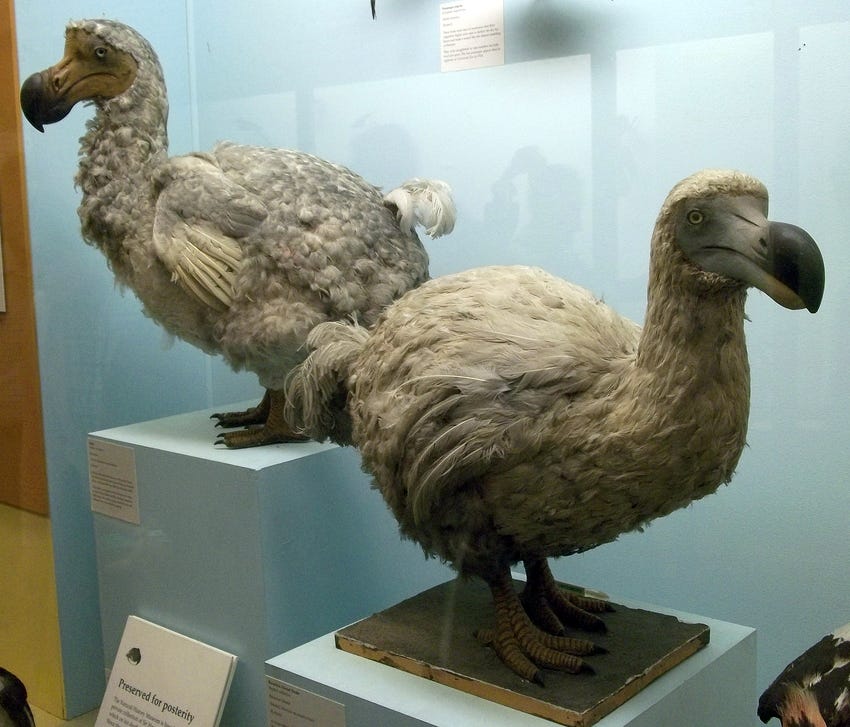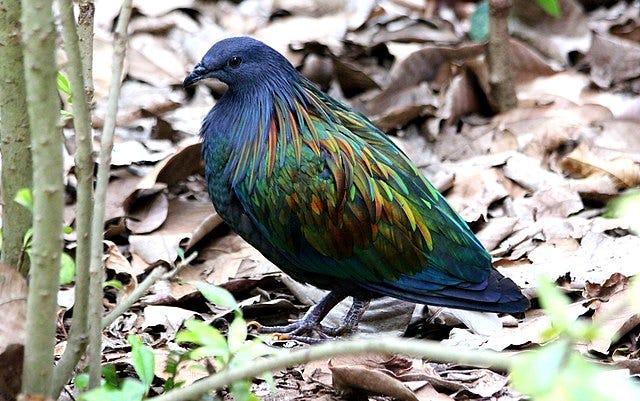Some notes on the dodo
A large and bumbling flightless metaphor.
Paid subscribers received this the day after last year’s presidential election. It felt apt.
Before that, though, the paperback of A History of the World in 47 Borders is out on Thursday – which, publishing doing as publishing does, means it is basically out now. Hurrah! If you’ve not read it and would like to, why not sign up for this deal under which you get 5% off a year of this newsletter AND a free copy?
Right. Dodos.
1. Four hundred years ago, the dodo was a large, flightless bird native to the Mascarene Islands – Mauritius, Reunion – of the Indian Ocean, around 500 miles off the coast of Madagascar.
2. Today, the dodo isn’t any of those things, because it’s extinct. Today, the dodo serves instead as a symbol of loss and extinction, with a slight but definite after taste of, “Wait, did we do that?”
3. For many years, based on a large number of terrible paintings and a rather smaller one of bones, scientists believed dodos to be a type of ostrich, vulture or albatross. More recent analysis of surviving skeletons, plus other evidence such as the fact the birds reportedly had clutches consisting of one egg at a time, have suggested it was in fact a huge, flightless pigeon. (Some sources say “pigeon or dove”, but all of us have to grow up sometime and admit to ourselves that doves are really just pretty pigeons.)
4. There’s actually quite a lot of uncertainty about the dodo’s actual appearance, due to a shortage of surviving specimens: the portraits we have look very different from one another, and not all of them were drawn from life. (Any made after the mid 17th century could only be based on earlier pictures.)

So far as we can tell though, dodos were slightly bigger than turkeys, with big heads and tiny wings. Their feathers are described variously as grey, blue-grey, brownish-grey or white; their large and heavy beaks may have been black, or pale yellow, or green. They probably had a white tail, but might not have done, and while we assume them to have been fat – up to 20kg! – it’s possible that this was a seasonal thing, or merely the result of the fact the most seen specimens were those kept in captivity. There’s a lot we simply don’t know.
5. The reason for dodos’ unusual appearance compared to their relatives is that they evolved in isolation on islands with no predators and plentiful food. Over the millennia, they grew bigger and heavier, while their wings shrank and fell out of use. Their closest living relative is thought to be the Nicobar Pigeon which, unexpectedly, looks like this:

6. Let’s talk etymology. One theory is that the word “dodo” comes from the Portuguese “doudo”, meaning “idiot” or “crazy”, a reference to the animals’ lack of fear of humanity. This seems unlikely, though, because there are relatively few Portuguese descriptions of the birds. Another possibility is that it’s an onomatopoeic recitation of the dodo’s call.
7. More likely, though, since Mauritius became part of the Dutch Empire in 1598 – its name comes from Maurice of Nassau – and since Dutch sailors provided the earliest descriptions of the bird, it comes from the, well, Dutch. “Dodor” means “sluggard”; “dodaar” means “fat-arse”. Both seem to fit.
8. The birds’ original name in Dutch, incidentally, was “walghvoghel”, which means “tasteless bird” – a charming reference to the fact that, despite looking like a good source of protein, they tasted rubbish.
9. In the 18th century, Carl Linneaus, the founder of taxonomy and a rather self-satisfied man, gave the dodo the latin name “Didus ineptus”. I’m not going to translate that for you.
10. This name was not only rude, it was also basically a guess because, even by Linneus’ time, the last dodo had been dead for some time. The birds had first been mentioned by Portuguese sailors around 1507; the last confirmed sighting was in 1662.1
11. What happened was, essentially, us. A lack of natural predators had allowed the birds to grow to an enormous size – as much as three feet tall – and left them unusually fearless and ill-equipped for self defence. But that meant that, when Europeans started showing up, they were easy pickings for hungry sailors. Who would then proceed to complain about their lack of flavour.
Probably worse than the humans was the impact of the creatures we brought with us – dogs, cats, pigs, even monkeys – and the habitat loss we wrought. In less than two centuries – no time at all, in evolutionary terms – they were all dead.
12. On the upside, the dodo was closely related to other species of giant flightless birds on other nearby islands: the Réunion solitaire, and the Rodrigues solitaire. Actually, the latter may have been a not especially closely related ibis…. but never mind that now, because by 1790 they were all dead, too.
13. Even in extinction, the indignities didn’t end. The Ashmolean Museum in Oxford had a taxidermied dodo, believed to be the last full specimen in Europe. In 1755, the museum’s director ordered it to be tossed onto a fire because it was getting mangy and starting to smell.2
14. For a period, many people assumed the dodo to have been a myth – which is pretty convenient, if you happen to be a member of the species that wiped them out. It was only in the 19th century, as zoology advanced and scientists began to examine surviving bits of dodos – a head here, a foot there, the odd skeleton – that they began to accept the horrific reality.
15. In 1865, the dodo became better known, after Lewis Carroll featured one in his popular – and illustrated – children’s book Alice in Wonderland. He is often said to have chosen it as an avatar of himself: because he had a stammer, and his real name was Charles Dodgson, he would sometimes introduce himself as “Do-do-Dodgson”. On the other hand, this story is both unsubstantiated, and kind of offensive. Either way, the illustrations did wonders for popular awareness of the Dodo.
16. In 1896, Hilaire Beloc also published this poem:
The Dodo used to walk around,
And take the sun and air.
The sun yet warms his native ground –
The Dodo is not there!The voice which used to squawk and squeak
Is now for ever dumb –
Yet may you see his bones and beakAll in the Mu-se-um
Which makes me feel very sad.
17. Elsewhere in fiction, in Jasper Fforde’s series of novels set in a weird parallel universe where books are still the main media and Swindon is a major city, his heroine Thursday Next has a pet dodo named Pickwick.
18. The least interesting companion Doctor Who had in the whole of the 1960s was named Dodo. The name, short for Dorothea, seems to have been chosen because it had the same number of letters as “Anne”, an abandoned character whose name had already been written into upcoming scripts.
The character, played by Jackie Lane, was not, alas, a dodo.
19. The website which purveys viral stories about animals being cute is also named The Dodo. I have never quite been able to shake the sense this is a front for something unnerving.
20. The dodo’s genome was sequenced in 2016. And there’s been discussion of whether it might be possible, by comparing the genetic code with that of the Nicobar pigeon, to bring the birds back.
There are no doubt good reasons not to do this, but man I want to see that Jurassic Park sequel.
21. Finally, it’s worth noting in passing the difference between “mass extinctions” – asteroids, climatic events and so on which take out a lot of species very quickly – and “background extinctions”, when habitat changes or bad luck mean individual species wink out of existence.
The latter, thanks to human activity, seems currently to be running at around a thousand times its trend rate.
I’m not sure recent political events are likely to help.
Some researchers have suggested there were sightings as late as 1690 – but even if that were correct, which we can’t know, it’s not substantially later.
A century and a half later, the barber and amateur collector Etienne Thirioux found a complete skeleton. The European scientific community was entirely disinterested in that, too, but it did eventually supply the material for proper research in the 2010s.
